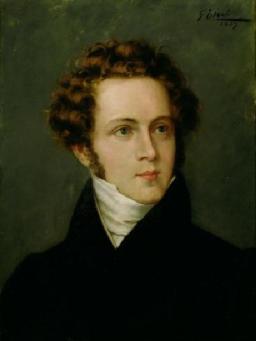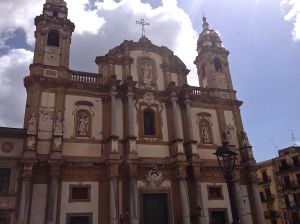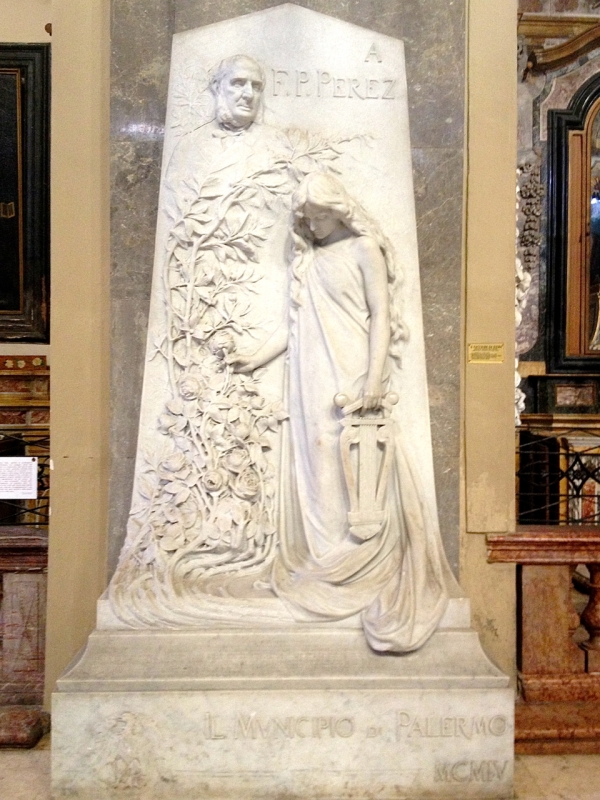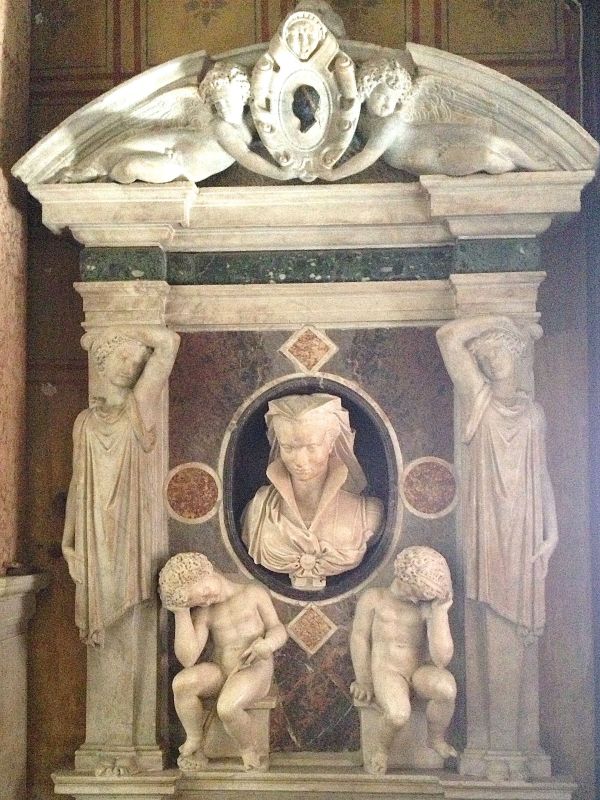Tags
Baroque, Francesco Crispi, Gian Lorenzo Bernini, Giuseppe Garibaldi, Italy, Palermo, Rome, Sicily, Travel

Tomb in San Domenico, Palermo
Tell you about them sobbin’ women
Who lived in the Roman days…
Oh, yes, them women were sobbin’
Sobbin’, sobbin’ buckets of tears
Mighty sad!
—“Seven Brides for Seven Brothers”
lyrics by Johnnie Mercer
Ever since I visited Sicily, this song from the übersexist but irresistible 1954 movie musical “Seven Brides for Seven Brothers” has been going through my head. As much as I’d prefer “O Sole Mio” or some other appropriately Italian earworm, this is what I got. Here’s why…
Arriving in late May, we visited the church of San Domenico, a baroque cathedral that, like many buildings in Palermo, looks a little run-down and rugged on the outside. Inside, however, we found a treasure trove of Sicilian history.
This cathedral is where many of Palermo’s noblemen and famous artists are buried, and each of the tributes, created by different artists, depicts a beautiful woman crying, mourning or generally mooning the guy buried there. Each figure has a romantic, ethereal and adoring vibe, but also a kind of trashy-novel sexiness that I just couldn’t resist. (Unfortunately, I couldn’t ID the one above.)
I started humming “Sobbin’ Women” (aka Sabine women) and wondering who these guys were who wanted to have gorgeous young women adoring them for eternity (what man doesn’t, I suppose). Clearly they were men of means, but were these women glorified representations of their wives? Or mistresses? Or just symbolic representations of some facet of the men’s lives? I really hoped it was the former, because how fun would that be?
I started researching. And now I wish I’d had a more detailed guidebook to tell me about these tombs when I was snapping the pics. Still, rather than sobbing buckets of tears about that, I wrote this down. So, here you go: Six “brides” for six Italian brothers-in-arms (or not) from Palermo, and beyond…
1. A Lover and a Fighter: Rosolino Pilo, 1820-1860
Pilo was a suave Sicilian revolutionary who had been torn between love of country and love for a woman. A younger son in a noble family, he’d initially been set to join the church but then opted to enter politics. The Bourbons ruled Sicily at the time and he got caught up in the 1848 fight for Sicilian independence. The revolution succeeded for sixteen months and he became part of the provisional government, which included a progressive constitution calling for a confederation of Italian states. But soon, the Bourbon army returned triumphant and Pilo fled Sicily, winding up in Genoa. And that’s where it gets juicy.
The social, handsome Pilo attended parties and balls and scandalously fell in love with another man’s wife, Rosetta Borlasca. According to letters he wrote to a friend about her, she was “an oasis for the outcast,” and he loved her madly. Her wedding band was about as much a deterrent as a red stoplight is to drivers today in Palermo—it’s only a suggestion! He wrote, “you know how it happens”: She had an arranged marriage; she doesn’t love the other guy; then one day she meets “a Sicilian with eyes of fire,” with ardor and elegance (if he does say so himself). If you were Rosetta, he asked his friend, what would you do?
Rosetta fell hard, and her husband’s rage knew no bounds. So inflamed was he that Rosetta’s father convinced Pilo to retreat to Nice to let things settle down. But before he did, the husband sent Pilo an insulting letter—calling the revolutionary hero a coward and a villain—and demanding satisfaction with a duel. But the husband never showed up. Rosetta promised her fuming father that she wouldn’t see Pilo anymore, and eventually Pilo got caught up again in Sicilian independence fighting. Their passionate love expressed itself only through their letters. She begged him not to go to war. He professed his undying love—then went to war.
When the Italian general Giuseppe Garibaldi landed in Palermo with his troops, Pilo was among them. And he fought until he was killed in a dramatic hail of bullets when Bourbon troops surprised the guerillas he led on the mountains of Monreale, near Palermo. Francesco Crispi, who became the premiere of the united Italy, recounted his death in a letter: “a ball struck him in the head, and [he] fell without being able to utter a word.” Garibaldi ensured that Pilo’s funeral would be paid for by the state. Nobody knows what became of Rosetta. Perhaps she’s looking over his tomb.
2. A Romantic Poet: Guiseppe de Spuches, 1819-1884
I was an English major, so I probably should’ve heard of Guiseppe, a Sicilian poet—but I hadn’t. And it turns out Google hasn’t either! Although I searched for some info on his life, what I found was that he was likely married to Giuseppina Turrisi Colonna (I can only hope he loved her as madly as Pino loved Rosetta).
I also found his poems. And he definitely had a romantic temperament. His poems are titled, “For Her,” “Loneliness,” “The Dove,” among many others.
“Loneliness” begins:
Virgin beautiful and dear,
The white pallor of her cheeks,
Oh! How melancholy,
Your face sculpts the altar of my heart!
Or something like that. My Italian isn’t quite up to translating 19th-century romantic poetry.
The woman looking lovingly over his grave is likely the muse of poetry.
3. A Scholar and Politician: Domenico Lofaso Pietrasanta di Serradifalco, 1783-1863
Say that name three times fast. The weeping woman on his grave isn’t quite so sexy, and since he was an architect, scholar and wrote several books about ancient and medieval Sicilian monuments, she’s probably a muse. Serradifalco, too, came from a noble Sicilian family, and studied architecture and archeology in Milan. After the 1848 revolution and for the brief period Sicily gained independence, he served as Speaker of Peers in the parliament and the country’s foreign minister.
Like Pilo, he was forced into exile after the Bourbons returned, and he fled to Florence. But when Garibaldi liberated Sicily, he returned to become President of the Commission of Antiquities and Fine Art.
On his tomb it reads: “He promoted Sicilian arts and letters with his mind and his inheritance.” So he put his money where his mouth was.
4. A Lover of Dante: Francesco Paolo Perez, 1812-1892
I love this lady, sculpted by Domenico Delisi, and I like to think she’s Beatrice, from Dante’s Divine Comedy. Information is scarce (online!) about Perez’s love life, but Beatrice definitely played a part—Perez was a Dante scholar.
I discovered that the F.P. on the tomb stands for Francesco Paolo, and that he was a mayor of Palermo. He, too, was involved in the 1848 revolution. Like the other men, he went into exile and returned to a political career in Palermo after 1860, becoming the Minister of Education. He wrote several books related to Dante, including The First Allegory and Purpose of the Divine Comedy and one titled Beatrice Unveiled.
From Palermo, we traveld through Sicily and wound up in Catania, where we found another interesting tomb:
5. An Opera Maestro: Vincenzo Bellini, 1801-1835
Here’s one man I had heard of: Vincenzo Bellini, an opera composer whose works are still performed today—the Metropolitan Opera includes three in the coming season, “La Sonnambula,” “I Puritani” and “Norma.” (See Anna Netrebko in a clip singing from “La Sonnambula” here.)
Bellini had been a child prodigy (just like my 400-year-old boyfriend Bernini). Legend has it he began studying music theory at age two, piano at three and wrote his first works at the age of six. It’s a good thing he got started so early because, sadly, he died at 33 from an acute inflammation of the intestine.
 Apparently he was quite a dandy, and the woman on his grave is obviously the muse (or angel) of music, because: 1.) she has wings; and 2.) Bellini, reportedly, was gay. His “central relationship” was with Francesco Florimo, and after Bellini’s death, one source I read says Florimo, a music historian, was treated as Bellini’s “spiritual heir,” whatever that means!
Apparently he was quite a dandy, and the woman on his grave is obviously the muse (or angel) of music, because: 1.) she has wings; and 2.) Bellini, reportedly, was gay. His “central relationship” was with Francesco Florimo, and after Bellini’s death, one source I read says Florimo, a music historian, was treated as Bellini’s “spiritual heir,” whatever that means!
6. Tragic Knowledge: Cardinal Domenico Pimentel, 1584-1653
Though this isn’t from Sicily—it’s found in Santa Maria sopra Minerva in Rome—the tomb of Spanish cardinal Pimentel is one of my favorites because Gian Lorenzo Bernini created the original design—although other artists carried out the production of the work.
No scandalous love life for the cardinal that I could find, so the sarcophagus is adorned with four allegorical figures: Charity, Justice, Knowledge and Faith, with the deceased Cardinal kneeling on top. But just look at the figure on the right (I think that’s Knowledge), sobbing with her hands over her face.
The anguish is palpable. Even in a work ultimately produced by other artists, Bernini’s ability to depict emotion that reaches out and grabs you by the throat is astounding.
Just when I was wondering where the women’s tombs are with hottie men standing over them, guess what I found? Also in Santa Maria sopra Minerva, hidden in a dark corner near the entrance is the tomb of Virginia Pucci.
Who was Virginia? Well…I can’t find anything about her online so until I dig a little deeper, she’s a 16th-century noblewoman, with lots of cherubs mourning her passing (no life-size weeping men for her).
I know what figure I wouldn’t mind overlooking my sarcophagus someday (a really, really long time from now)…
Ciao!













Sicily is on my list…what great photos.
LikeLike
Thanks! It’s definitely worth a visit.
LikeLike
Pingback: Fantasy Italian Dinner Party: Part 2—Anita Garibaldi | Searching For Bernini